Qi Yan
MoFlow: One-Step Flow Matching for Human Trajectory Forecasting via Implicit Maximum Likelihood Estimation based Distillation
Mar 13, 2025Abstract:In this paper, we address the problem of human trajectory forecasting, which aims to predict the inherently multi-modal future movements of humans based on their past trajectories and other contextual cues. We propose a novel motion prediction conditional flow matching model, termed MoFlow, to predict K-shot future trajectories for all agents in a given scene. We design a novel flow matching loss function that not only ensures at least one of the $K$ sets of future trajectories is accurate but also encourages all $K$ sets of future trajectories to be diverse and plausible. Furthermore, by leveraging the implicit maximum likelihood estimation (IMLE), we propose a novel distillation method for flow models that only requires samples from the teacher model. Extensive experiments on the real-world datasets, including SportVU NBA games, ETH-UCY, and SDD, demonstrate that both our teacher flow model and the IMLE-distilled student model achieve state-of-the-art performance. These models can generate diverse trajectories that are physically and socially plausible. Moreover, our one-step student model is $\textbf{100}$ times faster than the teacher flow model during sampling. The code, model, and data are available at our project page: https://moflow-imle.github.io
Coordinated Spectral Efficiency Prediction for Real-World 5G CoMP Systems
Aug 14, 2024Abstract:Coordinated multipoint (CoMP) systems incur substantial resource consumption due to the management of backhaul links and the coordination among various base stations (BSs). Accurate prediction of coordinated spectral efficiency (CSE) can guide the optimization of network parameters, resulting in enhanced resource utilization efficiency. However, characterizing the CSE is intractable due to the inherent complexity of the CoMP channel model and the diversity of the 5G dynamic network environment, which poses a great challenge for CSE prediction in real-world 5G CoMP systems. To address this challenge, in this letter, we propose a data-driven model-assisted approach. Initially, we leverage domain knowledge to preprocess the collected raw data, thereby creating a well-informed dataset. Within this dataset, we explicitly define the target variable and the input feature space relevant to channel statistics for CSE prediction. Subsequently, a residual-based network model is built to capture the high-dimensional non-linear mapping function from the channel statistics to the CSE. The effectiveness of the proposed approach is validated by experimental results on real-world data.
Fréchet Video Motion Distance: A Metric for Evaluating Motion Consistency in Videos
Jul 23, 2024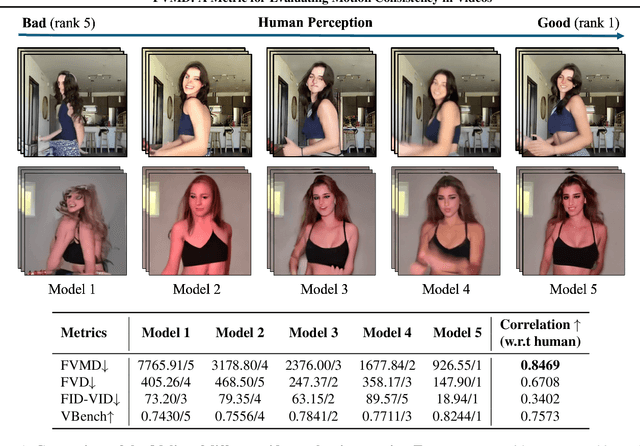
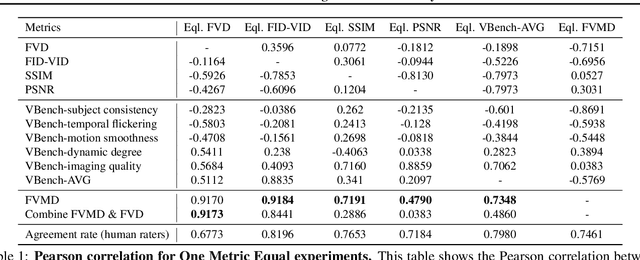

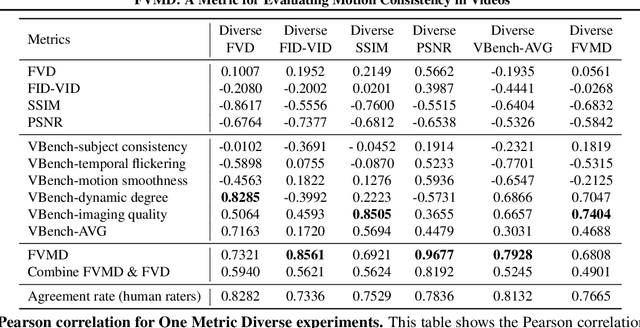
Abstract:Significant advancements have been made in video generative models recently. Unlike image generation, video generation presents greater challenges, requiring not only generating high-quality frames but also ensuring temporal consistency across these frames. Despite the impressive progress, research on metrics for evaluating the quality of generated videos, especially concerning temporal and motion consistency, remains underexplored. To bridge this research gap, we propose Fr\'echet Video Motion Distance (FVMD) metric, which focuses on evaluating motion consistency in video generation. Specifically, we design explicit motion features based on key point tracking, and then measure the similarity between these features via the Fr\'echet distance. We conduct sensitivity analysis by injecting noise into real videos to verify the effectiveness of FVMD. Further, we carry out a large-scale human study, demonstrating that our metric effectively detects temporal noise and aligns better with human perceptions of generated video quality than existing metrics. Additionally, our motion features can consistently improve the performance of Video Quality Assessment (VQA) models, indicating that our approach is also applicable to unary video quality evaluation. Code is available at https://github.com/ljh0v0/FMD-frechet-motion-distance.
4DHands: Reconstructing Interactive Hands in 4D with Transformers
May 31, 2024Abstract:In this paper, we introduce 4DHands, a robust approach to recovering interactive hand meshes and their relative movement from monocular inputs. Our approach addresses two major limitations of previous methods: lacking a unified solution for handling various hand image inputs and neglecting the positional relationship of two hands within images. To overcome these challenges, we develop a transformer-based architecture with novel tokenization and feature fusion strategies. Specifically, we propose a Relation-aware Two-Hand Tokenization (RAT) method to embed positional relation information into the hand tokens. In this way, our network can handle both single-hand and two-hand inputs and explicitly leverage relative hand positions, facilitating the reconstruction of intricate hand interactions in real-world scenarios. As such tokenization indicates the relative relationship of two hands, it also supports more effective feature fusion. To this end, we further develop a Spatio-temporal Interaction Reasoning (SIR) module to fuse hand tokens in 4D with attention and decode them into 3D hand meshes and relative temporal movements. The efficacy of our approach is validated on several benchmark datasets. The results on in-the-wild videos and real-world scenarios demonstrate the superior performances of our approach for interactive hand reconstruction. More video results can be found on the project page: https://4dhands.github.io.
Harnessing the power of longitudinal medical imaging for eye disease prognosis using Transformer-based sequence modeling
May 14, 2024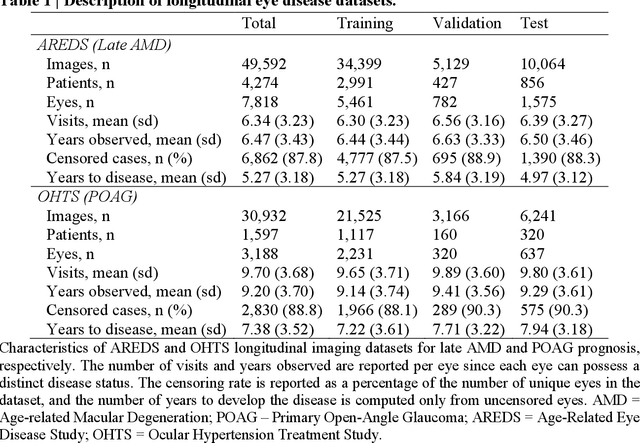

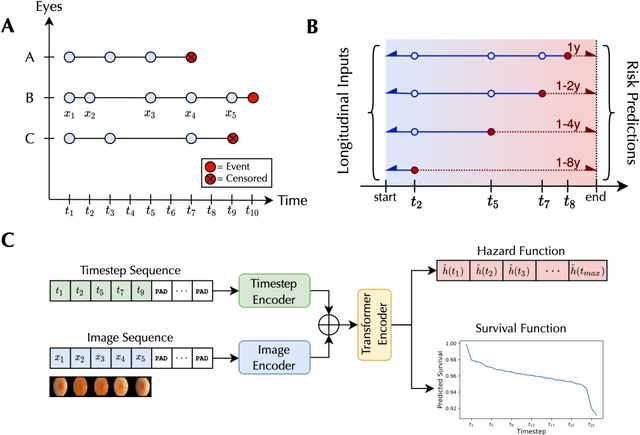
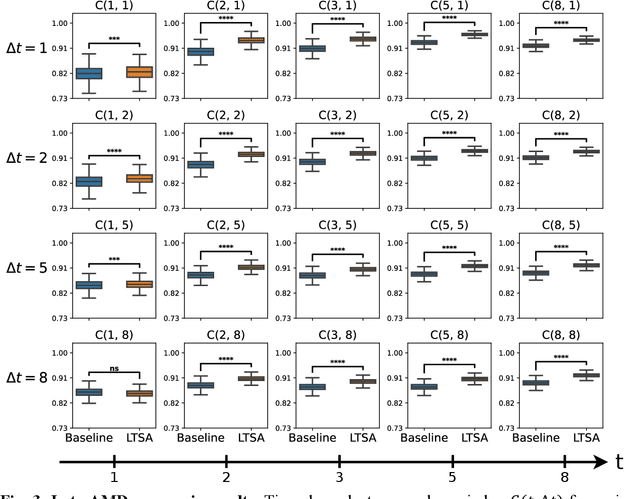
Abstract:Deep learning has enabled breakthroughs in automated diagnosis from medical imaging, with many successful applications in ophthalmology. However, standard medical image classification approaches only assess disease presence at the time of acquisition, neglecting the common clinical setting of longitudinal imaging. For slow, progressive eye diseases like age-related macular degeneration (AMD) and primary open-angle glaucoma (POAG), patients undergo repeated imaging over time to track disease progression and forecasting the future risk of developing disease is critical to properly plan treatment. Our proposed Longitudinal Transformer for Survival Analysis (LTSA) enables dynamic disease prognosis from longitudinal medical imaging, modeling the time to disease from sequences of fundus photography images captured over long, irregular time periods. Using longitudinal imaging data from the Age-Related Eye Disease Study (AREDS) and Ocular Hypertension Treatment Study (OHTS), LTSA significantly outperformed a single-image baseline in 19/20 head-to-head comparisons on late AMD prognosis and 18/20 comparisons on POAG prognosis. A temporal attention analysis also suggested that, while the most recent image is typically the most influential, prior imaging still provides additional prognostic value.
Video Diffusion Models: A Survey
May 06, 2024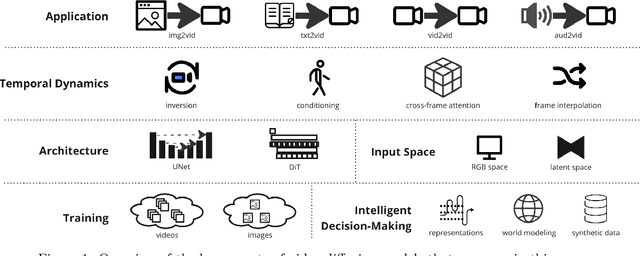

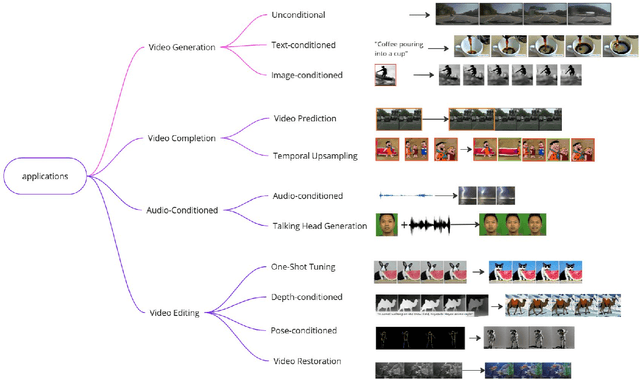

Abstract:Diffusion generative models have recently become a robust technique for producing and modifying coherent, high-quality video. This survey offers a systematic overview of critical elements of diffusion models for video generation, covering applications, architectural choices, and the modeling of temporal dynamics. Recent advancements in the field are summarized and grouped into development trends. The survey concludes with an overview of remaining challenges and an outlook on the future of the field. Website: https://github.com/ndrwmlnk/Awesome-Video-Diffusion-Models
Joint Generative Modeling of Scene Graphs and Images via Diffusion Models
Jan 02, 2024Abstract:In this paper, we present a novel generative task: joint scene graph - image generation. While previous works have explored image generation conditioned on scene graphs or layouts, our task is distinctive and important as it involves generating scene graphs themselves unconditionally from noise, enabling efficient and interpretable control for image generation. Our task is challenging, requiring the generation of plausible scene graphs with heterogeneous attributes for nodes (objects) and edges (relations among objects), including continuous object bounding boxes and discrete object and relation categories. We introduce a novel diffusion model, DiffuseSG, that jointly models the adjacency matrix along with heterogeneous node and edge attributes. We explore various types of encodings for the categorical data, relaxing it into a continuous space. With a graph transformer being the denoiser, DiffuseSG successively denoises the scene graph representation in a continuous space and discretizes the final representation to generate the clean scene graph. Additionally, we introduce an IoU regularization to enhance the empirical performance. Our model significantly outperforms existing methods in scene graph generation on the Visual Genome and COCO-Stuff datasets, both on standard and newly introduced metrics that better capture the problem complexity. Moreover, we demonstrate the additional benefits of our model in two downstream applications: 1) excelling in a series of scene graph completion tasks, and 2) improving scene graph detection models by using extra training samples generated from DiffuseSG.
AutoCast++: Enhancing World Event Prediction with Zero-shot Ranking-based Context Retrieval
Oct 03, 2023



Abstract:Machine-based prediction of real-world events is garnering attention due to its potential for informed decision-making. Whereas traditional forecasting predominantly hinges on structured data like time-series, recent breakthroughs in language models enable predictions using unstructured text. In particular, (Zou et al., 2022) unveils AutoCast, a new benchmark that employs news articles for answering forecasting queries. Nevertheless, existing methods still trail behind human performance. The cornerstone of accurate forecasting, we argue, lies in identifying a concise, yet rich subset of news snippets from a vast corpus. With this motivation, we introduce AutoCast++, a zero-shot ranking-based context retrieval system, tailored to sift through expansive news document collections for event forecasting. Our approach first re-ranks articles based on zero-shot question-passage relevance, honing in on semantically pertinent news. Following this, the chosen articles are subjected to zero-shot summarization to attain succinct context. Leveraging a pre-trained language model, we conduct both the relevance evaluation and article summarization without needing domain-specific training. Notably, recent articles can sometimes be at odds with preceding ones due to new facts or unanticipated incidents, leading to fluctuating temporal dynamics. To tackle this, our re-ranking mechanism gives preference to more recent articles, and we further regularize the multi-passage representation learning to align with human forecaster responses made on different dates. Empirical results underscore marked improvements across multiple metrics, improving the performance for multiple-choice questions (MCQ) by 48% and true/false (TF) questions by up to 8%.
SwinGNN: Rethinking Permutation Invariance in Diffusion Models for Graph Generation
Jul 19, 2023Abstract:Diffusion models based on permutation-equivariant networks can learn permutation-invariant distributions for graph data. However, in comparison to their non-invariant counterparts, we have found that these invariant models encounter greater learning challenges since 1) their effective target distributions exhibit more modes; 2) their optimal one-step denoising scores are the score functions of Gaussian mixtures with more components. Motivated by this analysis, we propose a non-invariant diffusion model, called $\textit{SwinGNN}$, which employs an efficient edge-to-edge 2-WL message passing network and utilizes shifted window based self-attention inspired by SwinTransformers. Further, through systematic ablations, we identify several critical training and sampling techniques that significantly improve the sample quality of graph generation. At last, we introduce a simple post-processing trick, $\textit{i.e.}$, randomly permuting the generated graphs, which provably converts any graph generative model to a permutation-invariant one. Extensive experiments on synthetic and real-world protein and molecule datasets show that our SwinGNN achieves state-of-the-art performances. Our code is released at https://github.com/qiyan98/SwinGNN.
What Constitutes Good Contrastive Learning in Time-Series Forecasting?
Jun 21, 2023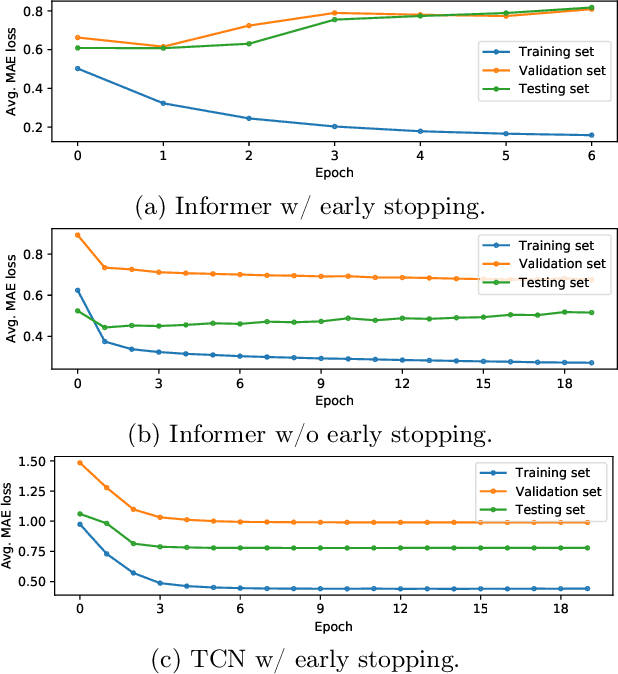
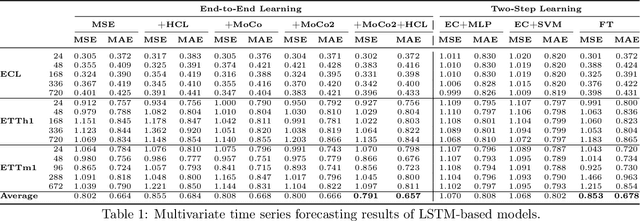

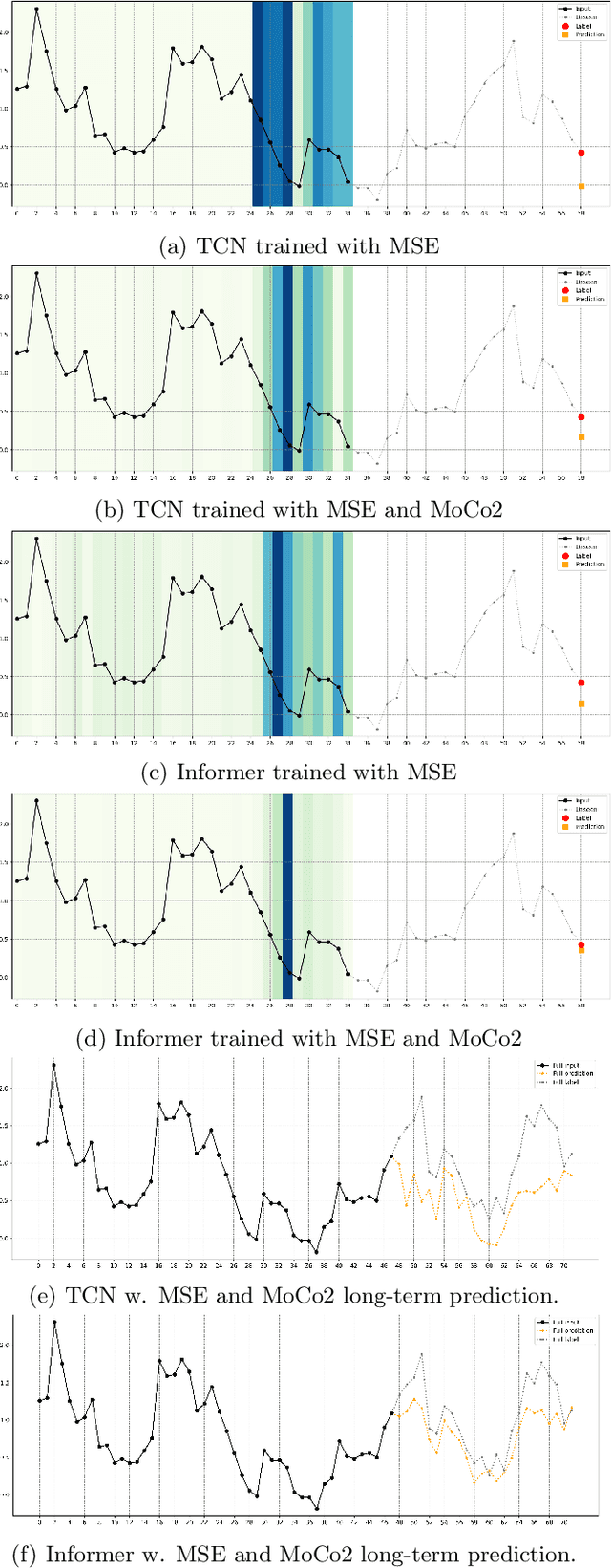
Abstract:In recent years, the introduction of self-supervised contrastive learning (SSCL) has demonstrated remarkable improvements in representation learning across various domains, including natural language processing and computer vision. By leveraging the inherent benefits of self-supervision, SSCL enables the pre-training of representation models using vast amounts of unlabeled data. Despite these advances, there remains a significant gap in understanding the impact of different SSCL strategies on time series forecasting performance, as well as the specific benefits that SSCL can bring. This paper aims to address these gaps by conducting a comprehensive analysis of the effectiveness of various training variables, including different SSCL algorithms, learning strategies, model architectures, and their interplay. Additionally, to gain deeper insights into the improvements brought about by SSCL in the context of time-series forecasting, a qualitative analysis of the empirical receptive field is performed. Through our experiments, we demonstrate that the end-to-end training of a Transformer model using the Mean Squared Error (MSE) loss and SSCL emerges as the most effective approach in time series forecasting. Notably, the incorporation of the contrastive objective enables the model to prioritize more pertinent information for forecasting, such as scale and periodic relationships. These findings contribute to a better understanding of the benefits of SSCL in time series forecasting and provide valuable insights for future research in this area.
 Add to Chrome
Add to Chrome Add to Firefox
Add to Firefox Add to Edge
Add to Edge